 |
Douglas County--1868 |
This is a NEGenWeb Project web page
and is presented as part of the
MARDOS Memorial Library Collection.
Douglas County--1868
|
While it is not strictly correct to use the date 1868 chronologically for Douglas County, that is the year when V. L. Vodicka, whose reminiscences furnished data, arrived. No doubt there was a number of Czechs who came prior to that date. For instance, L. A. Schlesinger and Joseph Horsky, who had settled in Washington County, the first in 1857, the second in 1859, probably came to Omaha to trade and were the first Czechs to enter the town. Edward Rosewater, who came to Omaha in 1863, was the first person born in Bohemia to become a permanent settler, although he did not associate with Czechs in any other than a political way. The next, as far as we know, was Vaclav Tucek, who came in 1864 or 1865. According to the census of 1920, there are in Omaha and South Omaha 4,305 persons born in Czechoslovakia, and it is estimated that the number of those of native birth or immediate Czech descent is near 12,000. These, with the exception of a few small farmers in the vicinity, represent the entire Czech population in the county. V. L. Vodicka (of whom mention has been made in the introduction), came to Omaha March 6, 1868, and according to his recollection, the following were here at the time. Most of them had come from Cedar Rapids, Iowa. Joseph Novacek, who conducted a boarding house on 12th Street near Dodge, which building later was used by Josiah Redfield for his printing house. Vaclav Sulek, died in Omaha. John Hula and F. Horak, both returned to Cedar Rapids, Iowa. George Dvorak, who had come from St. Louis, Mo., in 1867 and whose son, Joseph, later became county clerk of Colfax County. Eman Schlesinger, a carpenter, son of L. A. Schlesinger. Vaclav Kucera, born in Makov near Litomysle, 1847. He came to Omaha in 1868, in 1870 built a dance hall on Thirteenth Street, between Williams and Pierce, which later was converted into the first Bohemian Catholic church (St. Wenceslaus). In 1877 he built another on Leavenworth, between 13th and 14th, and later moved to Chicago. Joseph Zima; Vaclav Kovar, a tinsmith. Returned to Cedar Rapids, Iowa. Vaclav Stepanek. In 1869 he built the first Czech dance hall on Thirteenth and William Street, where Prague Hotel now stands. Frank and Joseph Mejstrik, brothers, who had been working as carpenters on railroad construction between Omaha and Cheyenne. 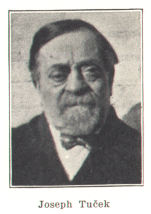
Vaclav Tucek, born in Caslav, 1837, came in 1864 or 1865. His son, Joseph, was the first Czech druggist. (Died Dec. 9, 1928.) John Reznicek, father of John Reznichek, who now has a grocery and meat store at 2711 Leavenworth street, Omaha. The elder Reznicek was a cigar maker and came in 1868. He left for West Point, Nebraska, where he died. The Marusak brothers, who took land in Butler County; Vaclav Basus; Frank Boukal; Matej Nerad; Frank Mares, married Eleonora Vodicka, V. L. Vodicka's sister. Lived long in Crete, Nebr. Joseph W. Zerzan (detailed mention in history of Colfax County); John Savlik; Anton Hajek; Thomas Killian,--(all three settled in Saunders County); Charles Jankele, moved to West Point, later died in Wisner; Joseph Kastl, settled in Saunders County; W. F. Kriz, Joseph Klikos, Anton Jansa, --(settled in Dodge County); John Dufek; Joseph Bures; Frank Pospisil, settled near West Point, died in Texas; F. Jilek, from Pittsburg, who later settled in Fremont and changed his name to Ellick; Anton Langer, Sr., a photographer, came in 1867, later to Florence, then to Cuming County. Died in West Point. 1869--The Following Came: 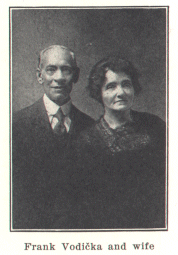
Pintner from Cleveland, Ohio, moved to Republic County, Kansas, where he died; Joseph Reznicek, a mason, from St. Louis, Mo.; Frank Koudele, moved soon to Wahoo, where he died; Frank Herold, a butcher, from Cleveland, settled in West Point; Matej K. Zirhut, born in Bezdekov near Klatovy. Came first to Mexico, with the Austrian Archduke Maxmilian, who was executed by the Mexicans, when he tried to impose himself as their Emperor. Zirhut moved to Crete, later to New Mexico, died in Albuquerque, N. Mex., in 1898. Ferdinand Vondrejs, moved to Saline County; the parents of Joseph F. Kavan, who settled in Saunders County; Joseph Papez, now living in Albion, Nebr.; John Stibal, now living in Richland, Nebr.; Martin and John Svacina, brothers, born in Zahorany near Domazlice, came from Wisconsin; John Konvalin; Frank Sojka; Joseph Novak; Vaclav Kavka; Thomas Kastner, died in Nebraska City; Joseph Kavka, who accidentally killed himself while helping by shooting to celebrate the founding of the Bohemian Slovanian Benevolent Society State Grand Lodge; Vaclav Fiala, a tailor; Frank Vrba; Vaclav Cuda, who settled in Saunders County; Sucha; Bednar, a brewer, who worked in the Bemis Brewery; Anton and John Spilinek, brothers. Anton settled in Howard County. John, in a fit of insanity, shot himself and wife in Omaha. Matej Nemec, a tailor; Nemec, a blacksmith; the Krepela brothers; Mrsny; Ondrej Matous, a carpenter, later moved to Plattsmouth, where he is living. During the first half of the seventies Omaha was truly a gate city for Czechs as well as others. Our people tarried just long enough to find out where they wanted to locate, or to earn the money necessary for payment on land. Consequently for several years the population, to a large extent, was transient. 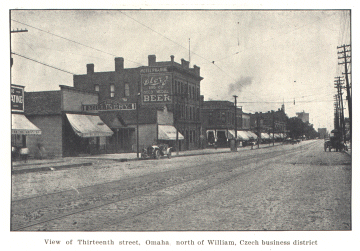 Some of the First Czech Business Men in Omaha Were: Zerzan & Dvorak, who conducted a grocery store in 1869. Stepanek's dance hall at Thirteenth & William street, built in 1869. Joseph Novacek's boarding house 1869. In 1871 Charles Jankele bought Stepanek's hall, later selling it to Vaclav Kucera. Kucera then built another (which later was remodeled into a church) and sold the old one to George Hoffman. M. Zirhut had a saloon and boarding house on Thirteenth near Leavenworth street. In 1877 there were living in Omaha less than a hundred Bohemian families. A large proportion of the men were employed in the smelting works, but few were in business. Vaclav Kucera conducted a dance hall, saloon and summer garden on Leavenworth, near Fourteenth street. A Bohemian Jew, Isaac Levy, had a grocery and later a general merchandise store on South Thirteenth, near Leavenworth, and a saloon in the adjoining building. Frank Pivonka, later one of the first Czech inhabitants of South Omaha, had a saloon on Seventh and Jones street. Martin Jansa, who moved later to Saunders County, had a grocery store near Kucera's Hall. 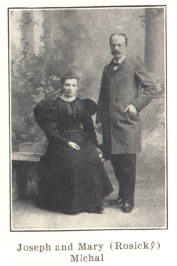
In 1876 John Svacina built a dance hall, which was destroyed by fire. Later it was rebuilt and called Metz Hall, now Catholic Sokol Home located at 1245 So. Thirteenth Street. About the time he built the hall, his brother, Martin, established a grocery across the street and then engaged in dry-goods business, which later was conducted by his daughter, Mary, now Mrs. Joseph Barta, after Svacina left for the west. In 1925 he returned to Omaha, where he is still living. In the late seventies Vaclav Hnizdil moved in from Blair and bought the Davenport House, on Farnam near Ninth. Later he bought the corner on Thirteenth and Harney, where he conducted a boarding house and saloon. Afterward he took up his trade of baker. Died a few years ago. About that time John W. Honza, a Civil War veteran, came from Iowa City, Iowa, and established a boarding house. The first baker was Frank Kubovec, who built an oven under the front part of the old Svacina Hall, afterward building a regular bakery at about 1264 South Thirteenth street. Later he moved to Cleveland, Ohio. The first Bohemian meat shop was that of Anton Pokorny, corner of Thirteenth and Jones streets. Pokorny now lives in Oklahoma. Joseph Palik established the first hotel at 1109-1111 South Thirteenth street. The Czech settlement in Omaha of those days for a long time was situated in the vicinity bounded by Tenth Street on the east, Sixteenth on the west, Pierce on the north and Center on the South, and was known as "Praha" (Prague) in Czech and "Bohemian Town" in English. During the boom of the eighties Omaha prospered and many new people came. Czechs have always been industrious and frugal, for those in this country were, with small exceptions, poor immigrants, with nothing but their bare hands for first capital. Some settled along the river bottoms, or "squatted" there. As their numbers grew, they settled in Sheeley, where they were later replaced by Polish people. The district known as Brno (named for the capital city of Moravia), lying between Tenth and Thirteenth street south of Riverview Park, is almost entirely settled by Czechs. As the city grew and prospered, they prospered also, so that at this date many occupy fine homes and are found in all walks of business and professional life. They no longer live exclusively in certain localities, but all over the city, many having beautiful residences. In the early days quite a number worked in the smelter. They have been supplanted by other nationalities, but there is still a goodly number of them working in the packing plants of South Omaha and a large settlement lives there, with its proportionate number of business and professional men. Frank Pivonka was the first Czech to settle there. He was born January 19, 1840, and built the Pivonka Block. 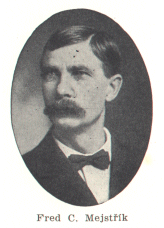
Fred Mejstrik (Maystrick) who lived in Omaha since he was a boy of ten, gave the following account of his pioneer days: "My parents took a claim near North Bend in 1868, but never proved on it and lost it. Early in May, 1870, they bought twenty-four acres south of Gibson (Omaha), at which time there was no railroad there. In the spring of 1872 they went to Cleveland, Ohio, crossing the Missouri river over the new railroad bridge. When we arrived in Omaha, we came over by ferry. During our first winter in Gibson the Indians killed sixty deer between that place and Bellevue. My oldest brother Joseph and my father killed a deer with a set of oars. They were in a boat, fishing on the Missouri, when they beheld a deer swimming over from the Iowa side. Not having weapons, they beat him to death with their oars. The Indians used to stop at our home almost every day during the winter, to get warm. They were half naked and I, as a boy, used to marvel how they could stand the cold as well as they did. They camped near a lake called Hard Wood Lake, two miles south of Gibson. Once when my brother Anton and I came home after selling fish, five Indians followed us. One was about eighteen years old and could speak fairly good English. We entered into conversation. About two weeks before that the train had killed our neighbor's cow and they buried it next to the railroad tracks. Anton told the Indian about it and he asked to be shown the place. After uncovering the animal, we asked the Indian what he thought of it, and he said he thought the hind quarters were all right These Indians used to come down the Missouri River in the fall in boats made by hollowing out tree trunks. It was surprising to note how well they could handle them without capsizing. Indian families came with horses having poles tied to their sides, and leather tied crosswise, thus forming sacks for papooses and luggage. In those days they had no wagons. They dressed in true Indian fashion, buckskin, fringed leggings, beads and moccasins, and as I said before, the way they withstood the cold was astonishing. I have seen them walk on ice which was covered with four inches of water, wading in it to spear muskrats through their houses. My people used to put up cord wood pulled from the Missouri River and sold it to steamboats. In the spring of the year the sandbars were covered with ducks and geese, which came by the thousands. Wild turkeys also were plentiful in those days. In 1870 the main business section of Omaha extended from the depot on Ninth Street to Farnam, then along Farnam to Fourteenth Street. I walked to school from Gibson to where St. Joseph's Hospital stands. The following spring one of the pupils, Charles Snell, married our teacher. At that time there was no South Tenth Street, merely a wagon road, and the only house in the district was owned by C. F. Goodman, the wholesale druggist, located at Ninth and Francis streets. It was from his home that the school children obtained drinking water. We left for Cleveland, Ohio, in 1872, but in 1876 my brothers, Frank and Anton, returned. My father died April 6, 1879, in Cleveland, and I came to Omaha in August of that year. The following winter I chopped wood for Fred Drexel, at 75 cents per cord. That was on about O and Q streets, between Thirteenth and Twentieth, in South Omaha, then of course all hills and valleys. We averaged about a cord a day, and in the spring I came out ahead with $5.35. From that time until 1883 I divided my time between Omaha and Cleveland. In 1883 I stayed at the Emmet House (on Eleventh between Farnam and Harney streets), where I fell in love with Mary Vcela. We were married May 7, 1883, and have lived happily ever since, raising a family of three boys and three girls, all of whom reside in Omaha. My eldest daughter, Emily, became the wife of John G. Rosicky." (Mr. Mejstrik died January 11, 1928, aged 66 years.) At time of writing this history, Joseph Tucek and Frank Vodicka were the oldest living Czech pioneers of Omaha. |
| Back | Table of Contents | Next |